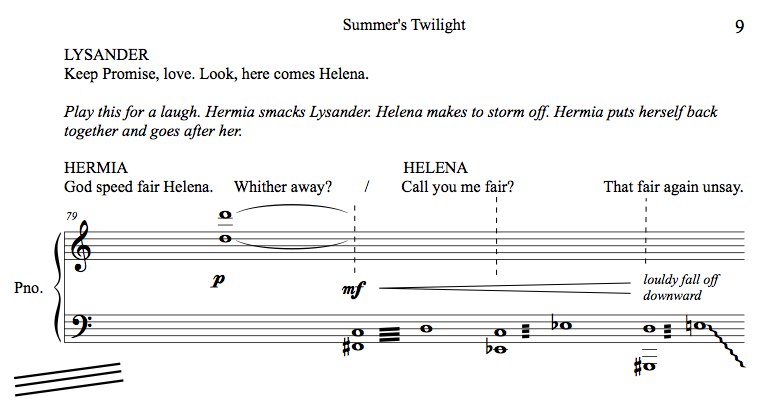Last month I gave a hybrid talk at the Rhymes with Opera summer training program for singers and composers. Part of it was based on the same material as my talk for Fresh Inc., and the other part concerned my approach to putting music in theater.
For the last few years I’ve been experimenting with different ways to notate the control of time in my scores, and this talk was a great opportunity to look back and codify the techniques I’ve devised.
Most of my recent works are for the theater, and a lot of the power of straight theater comes in working in the rehearsal room, with the actors and director, on very fine control of time. How slowly do you turn? How do you deliver a line? What physical actions do you need to take in what time in order to tell the story?
Traditionally notated music also relies on very fine control of time, but the straight play and the traditional musical score control time in completely different ways. It’s almost as if they were two separate programming languages, or polar and cartesian coordinates. Both systems are capable of defining any duration of time for any reason, but each language is best suited to certain kinds of things. A musical score is better for controlling metrical and repeated figures, or overlapping elements. A script is much more open-ended, and is better for controlling story, and for giving the production crew a method to build a precise timing for their production.
To my mind, trying to do theatrical timing with a traditional, and fully notated score is impossible. By using the language of the musical score, you are depriving the director and designers of their favorite tools to control time, the programming language they use most. Almost every opera production shows the problems you run into working this way. You’ll reach the end of a scene, and there will be 30 seconds or so of music left. The demands of the story and of the production are finished, but there’s more music, so the director has to come up with “a bit of business” to cover the time.
Whenever I see that “bit of business” in a show, I come straight out of the story. This bothers me more than other people, and that’s fine. My ideal performance takes a lot from Peter Brook’s theater, and his notion of what it takes for a performance to be “alive”, where every motion and its timing takes on a depth of meaning communicative power, and where the attention of the audience is completely held by the stage. It’s not the ideal performance of a lot of composers of traditional opera and that’s fine – in fact it makes their lives easier. they don’t have to come up with a musically notated version of coordinate substitution.
But I have to make the languages work together to create the art I want to create. So I’ve invented a set of notational techniques to bridge the gap between the two systems of script and score. At heart, what I do is notate which element of the production is in control of time at any given moment, whether it’s an instrument, the spoken text of an actor, some movement designed to be created in rehearsal to tell a story, or yes, sometimes the traditionally notated music itself.
In order to specify what element should be in control, I have to notate music in a lot of unfamiliar ways. If you look at my scores, you’ll see stemless noteheads aligned under spoken words so that instruments have to follow the changing rhythms of speech. You’ll see collections of gestures for instruments meant to be reassembled to create music for a mimed scene, and you’ll see spoken text marked with ‘x’ noteheads when speech has to follow music.
The challenge in this style of notation isn’t so much how to be specific as it is to be readable. The score still has to make sense as you go through it. And it has to make sense to actors, musicians, directors, and designers. Your score is no good if the running crew can’t follow it when it’s time to change the lights or move a set.
It’s been a very difficult, and very rewarding technical challenge to develop this method of notation. Now, after the methods have been created, I get to play with art in the way I’ve always wanted.
